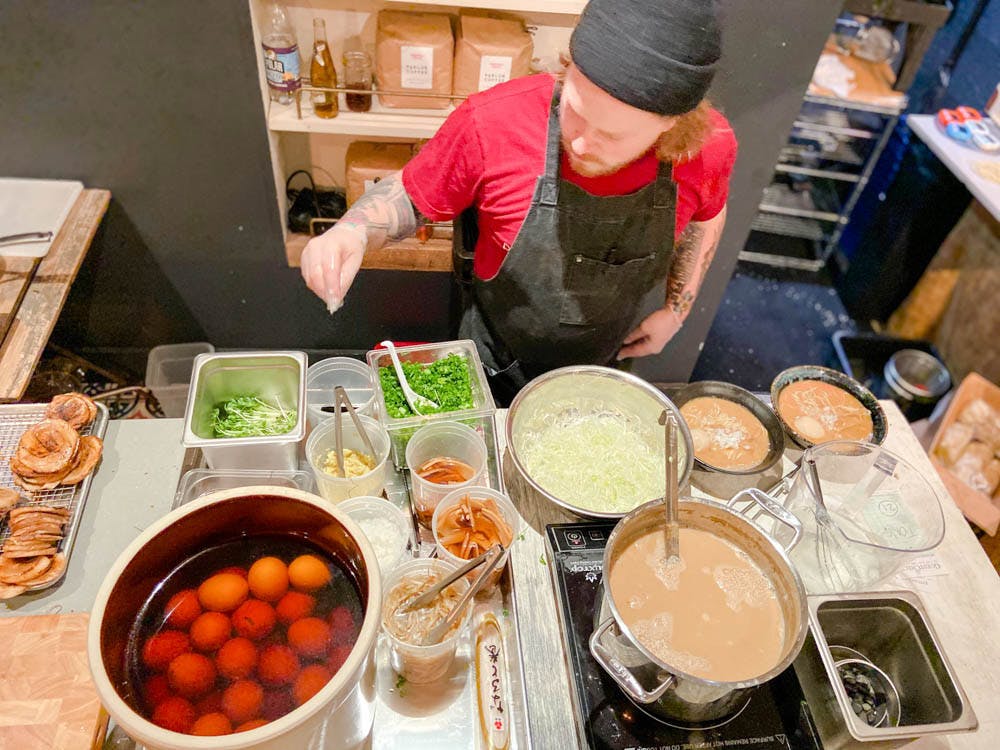Inside the coffee shop, slices of braised pork belly sizzle under the flame of a blowtorch; plump soft-boiled eggs soak in a sweet shoyu marinade; slivers of fermented bamboo shoots curl in tupperware. Saturday night saw lattes and cappuccinos make way for ramen during a special event called Ramen Night at The Shop, a small cafe on Wickenden Street.
This past weekend, Scott LaChapelle’s Providence Ramen had its third pop-up event at the local coffee shop. The event sold over 125 bowls and fielded a line that stretched out past the small, red paper lantern hung next to The Shop’s usual wooden sign.
LaChapelle, a Providence resident, has been making ramen for nearly three years. He got hooked by a bowl from a shop outside a train station in Kyoto in 2017 and has been working towards perfecting his craft since then.
“You have to be willing to let yourself fail and produce something bad over and over again,” LaChapelle said. He’s been tinkering with all the aspects of the dish since he started his journey — from bowl temperature to the blend of soy sauces that season the broth to the braised pork on top.
For the event on Saturday, LaChapelle served a $16 shoyu bowl with chicken and dashi soup for a lighter, cleaner flavor as well as a $17 miso bowl with a heartier, thicker broth packing a spicy kick. The special of the evening was a $20 Tonkotsu Gyokai, pork bone broth and dashi double soup base topped with pork shoulder. The bowls were decorated with soft-boiled eggs, menma, scallions, ginger, nori and bean sprouts.
Ramen is a complex dish. The soup, seasoning (tare), noodles and toppings have near infinite permutations. Each element must be balanced for taste, prepped on time for service and laid-out and ready for constructing a piping-hot bowl within minutes of a customer’s order. Prep time for the bowls, with simmering soups, resting dough and marinating eggs, can reach up to 30 hours, according to LaChapelle.
Shops tinker for years to get the combinations right and guard them jealously. LaChapelle is similarly protective of his secrets; he only specified that he uses a mixture of light and dark shoyu in his six-sauce tare blend and wouldn’t reveal the spices providing the kick in the miso ramen served at The Shop.
“Dashi is something that’s really personal,” LaChapelle said. Part of the soup, dashi is traditionally made by simmering kombu seaweed, bonito and water, but variations can be made with everything from tomato to squash to pumpkin.
“If you want to bring warmth to it, if you want to bring acidity to it, it’s all personal feel,” LaChapelle said.
At least 11 different vessels sat before LaChapelle at his station in The Shop, from simmering soup to menma to chashu lined up and waiting for the torch.
Managing ingredients is key to mastering ramen. LaChapelle estimates that a single bowl of noodles can use 25 different ingredients, many of which he often makes from scratch.
Complicating this, LaChapelle has to order some crucial ingredients like bonito flakes — dried tuna flakes widespread in Japanese cooking — from Japan.
But as a resident of the Ocean State, LaChapelle strives to source local ingredients whenever possible. He gets greens, like the crystal-green sliced scallions piled above the noodles, from Wishing Stone Farm in Little Compton, Rhode Island. LaChapelle uses local littleneck clams to flavor some of his soups and gets his miso from South River Miso across the border in Conway, Massachusetts.
The chicken in the soup comes from Baffoni’s Poultry Farm in Johnston, Rhode Island. Paul Baffoni, one of the owners of Baffoni Poultry Farms, said the farm delivers its chicken the day after processing. “It’s as fresh as it could possibly be,” Baffoni said.
At the moment, LaChapelle’s ramen is only available at pop-ups, but he would someday enjoy owning his own place.
Since Ken’s Ramen closed in late December 2018, ramen options in Providence have been limited.
“I’ve been missing a diversity of ramen. I was really excited to see a new place,” said Alexander Benjamin ’22. Benjamin has business cards from his favorite NYC ramen shops strung up along his dorm room wall. He praised the quality of the soup and said he enjoyed watching the blowtorch flame the chashu right before service.
Daniel Wang ’22 said he found the dishes underwhelming, especially given what he described as high price points and a long wait outside the shop.
At the last pop-up, LaChapelle integrated a component of his Portugese identity by using marinade from Mello’s Chourico and Linguica in Fall River, Massachusetts. He plans to keep developing his craft, incorporating nods to his identity and the locale while maintaining the integrity of the dish’s heritage.
“I love repetition. I love working at something every day and getting better and better at it day by day,” LaChapelle said. “What I’m doing today is, after this, I’m going to go home and grab them all and make a new mix and see what happens.”





